EDUCATING
Young Children
With
Autism Spectrum
DISORDERS
EDUCATING
Young Children
With
Autism Spectrum
DISORDERS
ERIN E. BARTON  BETH HARN
BETH HARN
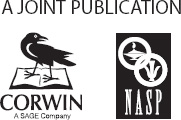
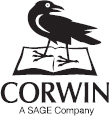
FOR INFORMATION
Corwin
A SAGE Company
2455 Teller Road
Thousand Oaks, California 91320
(800) 233-9936
www.corwin.com
SAGE Publications Ltd.
1 Olivers Yard
55 City Road
London, EC1Y 1SP
United Kingdom
SAGE Publications India Pvt. Ltd.
B 1/I 1 Mohan Cooperative Industrial Area
Mathura Road, New Delhi
India 110 044
SAGE Publications Asia-Pacific Pte. Ltd.
3 Church Street
#10-04 Samsung Hub
Singapore 049483
Acquisitions Editor: Jessica Allan
Associate Editor: Allison Scott
Editorial Assistant: Lisa Whitney
Production Editor: Amy Schroller
Copy Editor: Tina Hardy
Typesetter: Hurix Systems Pvt. Ltd.
Proofreader: Eleni-Maria Georgiou
Indexer: Maria Sosnowski
Cover Designer: Lisa Riley
Graphic Designer: Rose Storey
Permissions Editor: Karen Ehrmann
Copyright 2012 by The National Association of School Psychologists (NASP)
All rights reserved. When forms and sample documents are included, their use is authorized only by educators, local school sites, and/or noncommercial or nonprofit entities that have purchased the book. Except for that usage, no part of this book may be reproduced or utilized in any form or by any means, electronic or mechanical, including photocopying, recording, or by any information storage and retrieval system, without permission in writing from the publisher.
Printed in the United States of America
A catalog record of this book is available from the Library of Congress.
ISBN 978-1-4129-8728-8
This book is printed on acid-free paper.
12 13 14 15 16 10 9 8 7 6 5 4 3 2 1
Contents
Erin E. Barton
Erin E. Barton
Erin E. Barton and Beth Harn
Dylan S. Carelli and Erin E. Barton
Erin E. Barton
Beth Harn, Shanna Dee Davis, and Erin E. Barton
Brian Reichow and Terrell Reichow
Sarah E. Pinkelman and Erin E. Barton
Matt Tincani and Jessica Zawacki
Summer Ferreri and Joshua Plavnick
Kathleen Strickland-Cohen and Beth Harn
Lois Pribble and Erin E. Barton
Acknowledgments
Corwin gratefully acknowledges the contributions of the following reviewers:
Carol Aymar
Elementary school teacher
Francis W. Parker School
Chicago, IL
Joyce Williams Bergin
Professor of Special Education and
Assistant Dean of the College of Education
Armstrong Atlantic State University
Savannah, GA
Katherine Boone
Case Manager
MHMRA of Harris County
Houston, TX
About the Authors
Erin E. Barton, PhD, BCBA-D, is an assistant professor in the School of Education and Human Development at the University of Colorado Denver. She teaches courses in early childhood special education on evidence-based assessment and intervention practices for young children with special needs and their families. She is a Board Certified Behavior Analyst and has worked with children and families in school, home, and clinic settings. Prior to her current position, she was a special education teacher for the Chicago Public Schools, where she taught young children with autism. Dr. Barton specializes in the education of young children with developmental disabilities in inclusive and naturalistic settings. Her research interests include early intervention and identification of young children with autism, behavioral interventions for young children with developmental disabilities, and professional development of early childhood special education teachers. She has published several papers on evidence-based practices for young children with autism. Also, she regularly provides professional development to programs, school districts, and states on evidence-based, early intervention practices for young children with special needs and their families.
Beth Harn, PhD, is an associate professor within the Department of Special Education and Clinical Sciences at the University of Oregon. She teaches classes in special education and school psychology including instructional design, educational assessment, introduction to learning disabilities, and systems level academic interventions. Expertise areas include early identification, data-based decision making, and designing and delivering effective reading and behavioral interventions. She is currently coprincipal investigator on a number of federally funded initiatives related to reading, attention development, and traumatic brain injury interventions as well as special education teacher preparation. Her research interests focus on early intervention for students with reading and learning difficulties by implementing schoolwide, coordinated instructional and assessment practices and designing intensive interventions. Recently her intervention efforts have included designing computer-delivered supports. She also provides professional development to states, districts, and schools nationally to support the implementation of response to intervention practices. Prior to her current position, she worked as a school psychologist in the Central Valley of California.
1
Classification of Autism in Young Children
Erin E. Barton
University of Colorado Denver
Chapter Objectives:
- Describe the symptomatology of autism spectrum disorders.
- Describe the variability in autism symptomatology across people with autism.
- List and describe the autism spectrum disorders with the DSM-IV-TR.
- Describe two autism classification systems (DSM-IV-TR & ICD-10).
- Describe the current prevalence of autism and the issues associated with measuring the prevalence.
A utism is a neurobiological developmental disorder initially characterized by Leo Kanner (1943) and Hans Asperger (1944). Since their initial descriptions, the identification and classification of autism have undergone many iterative changes. The current approach to autism provide descriptions of the autism identification processes. Autism is not a single disease. It is characterized by a spectrum of disorders, which varies across and within children over time. In most cases, autism first appears in early childhood and continues throughout adulthood. Advancements in autism treatment often lead to improved outcomes over time.
Autism symptomatology manifests with much variability. Today there are several different conditions related to autism commonly known as Autism Spectrum Disorders (Volkmar, State, & Klin, 2009). The term autism is used throughout this book to refer generally to children with Autism Spectrum Disorders. Although there are many commonalities, there is no single behavioral marker for autism. The hallmark autism symptoms are deficits in social behaviors. The criteria used for classification of autistic disorder mirror the triad of impairments first described by Leo Kanner (1943). Characteristics include qualitative impairments in social interactions, communication, and restricted, repetitive, and stereotyped patterns of behavior. Additionally, delays in social interaction, communication, or symbolic play must be present before the child turns 3 years old (American Psychiatric Association, 2000).
Next page

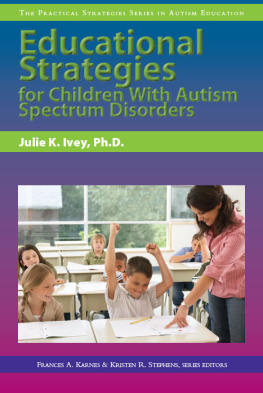


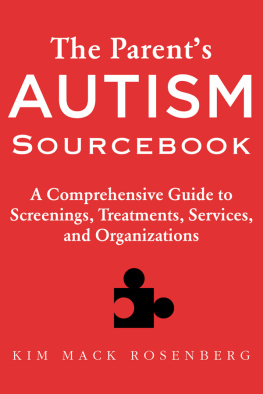

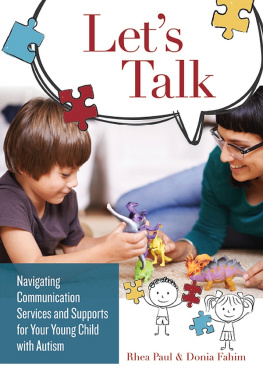
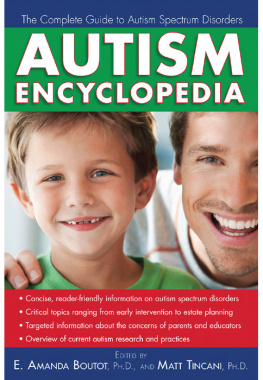
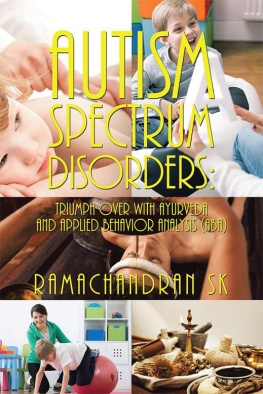

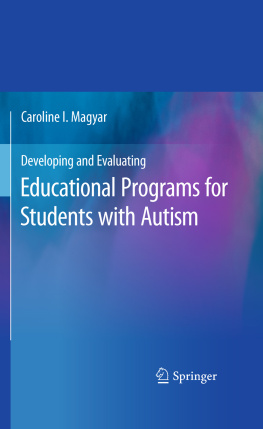
 BETH HARN
BETH HARN
